Feasibility Study on Temperature Distribution Measurement Method of Thrust Sliding Bearing Bush Based on FBG Quasi-Distributed Sensing
Abstract
:1. Introduction
2. Method of Measurement
2.1. Bearing Bush Structure and Working Charateristics
2.2. FBG Quasi-Distribution Measurement Method for Temperature Distribution of Bearing Bush
2.3. FBG Temperature Sensors Laying
3. Measurements and Experimental Research
3.1. Preparation of FBG Measuring Body for Thrust Sliding Bearing Bush
3.2. Calibration of FBG Temperature Sensors
3.3. Experimental Test
3.4. Experimental Results and Analysis
4. Results
Author Contributions
Funding
Conflicts of Interest
References
- Jiang, X.; Lu, J.; Lu, M.; Bin, B. Thrust bearing structure and characteristics of large hydrogenerator set. Hydroelectr. Power 2015, 41, 61–65. [Google Scholar]
- Huang, H. Mechanism and Technology Research on Typical Failure Treatment of Sliding Bearing of Large Unit; Xi‘an Jiaotong University: Xi‘an, China, 2011. [Google Scholar]
- Zhu, J. Analysis of high temperature treatment process of thrust pad of 300MW vertical circulating pump motor. Shihezi Sci. Technol. 2011, 6, 26–27. [Google Scholar]
- Ma, X.; Zhao, M. Fracture failure analysis of thrust sliding bearing disc of large HDPE extruder. Therm. Process. Technol. 2014, 43, 223–225. [Google Scholar]
- Chen, G.; Guan, K. Failure analysis of thrust sliding bearing of extruder. Phys. Chem. Test. 2012, 8, 508–546. [Google Scholar]
- Wodtke, M.; Fillon, M. Study of the Influence of Heat Convection Coefficient Predicted Performance of a Large Tilting-Pad Thrust Bearing. J. Tribol. 2013, 135, 1–11. [Google Scholar] [CrossRef]
- Liming, Z.; Yongyao, L.; Xin, L.; Funan, C.; Yexiang, X.; Zhengwei, W. Numerical simulations for the fluid-thermal-structural interaction lubrication in a tilting pad thrust bearing. Eng. Comput. 2017, 34, 1149–1165. [Google Scholar]
- Yu, X.; Geng, L.; Zheng, X.; Wang, Z.; Wu, X. Matching the relationship between rotational speed and load-carrying capacity on high-speed and heavy-load hydrostatic thrust bearing. Ind. Lubr. Tribol. 2018, 70, 8–14. [Google Scholar] [CrossRef]
- Jiao, Y.; Huang, M.; Wang, X.; Shen, J.; Nie, Z.; Yu, G.; Li, M. Experimental research on PTFE watt thrust bearing. Ind. Control Comput. 2016, 29, 68–69. [Google Scholar]
- Glavatskih, S.B. A method of temperature monitoring in fluid film bearings. Tribol. Int. 2004, 37, 143–148. [Google Scholar] [CrossRef]
- Yuan, Y. Portable Thrust Bearing Data Acquisition and Display System Based on Labview; Xihua university: Chengdu, China, 2017. [Google Scholar]
- Cristea, A.F.; Bouyer, J.; Fillon, M.; Pascovici, M.D. Transient Pressure and Temperature distribution Measurements in a Lightly Loaded Circumferential Groove Journal Bearing from Startup to Steady-State Thermal Stabilization. Tribol. Trans. 2017, 60, 988–1010. [Google Scholar] [CrossRef]
- Wei, W.; Wang, L.; Yu, J.; Gao, G.; Yu, X. Infrared measurement and reconstruction of transient temperature distribution of joint bearings. J. Bear. 2016, 14, 25–47. [Google Scholar]
- Kersey, A.D.; Davis, M.A.; Patrick, H.J.; LeBlanc, M.; Koo, K.P.; Askins, C.G.; Putnam, M.A.; Friebele, E.J. Fiber grating sensors. Lightwave Technol. 1997, 15, 1442–1462. [Google Scholar] [CrossRef]
- Han, Y.G.; Dong, X.; Lee, J.H.; Lee, S.B. Simultaneous measurement of bending and temperature based on a single sampled chirped fiber Bragg grating embedded on a flexible cantilever beam. Opt. Lett. 2006, 31, 2839–2841. [Google Scholar] [CrossRef] [PubMed]
- Yan, L.S.; Yi, A.; Pan, W.; Luo, B. A simple demodulation method for FBG temperature sensors using a narrow band wavelength tunable DFB laser. IEEE Photon. Technol. Lett. 2010, 22, 245–248. [Google Scholar] [CrossRef]
- Xi, H. On-Line Monitoring of Temperature Distribution of Transformer Winding and Study of Influencing Factors by FBG; Chongqing University: Chongqing, China, 2012. [Google Scholar]
- Tang, L. Research on High-Speed Railway Track Safety Monitoring System Based on FBG in Cold Region; Heilongjiang University: Heilongjiang, China, 2013. [Google Scholar]
- Hong, J. Measurement Technology of Temperature Distribution near Drill Bit Based on Fiber Grating [D]; Hefei University of Technology: Hefei, China, 2014. [Google Scholar]
- Tan, J. Research and Application of Temperature Distribution Monitoring Technology in Goaf of Coal Mine Based on FBG; Wuhan University of Technology: Wuhan, China, 2015. [Google Scholar]
- Yuan, P. Research on Motor Temperature Testing System Based on Bragg Fiber Bragg Grating; North University of China: Taiyuan, China, 2013. [Google Scholar]
- Liu, S. Study on the Lubrication Performance of Tilting Tile Thrust Bearing Based on APDL; Harbin University of Science and Technology: Harbin, China, 2015. [Google Scholar]
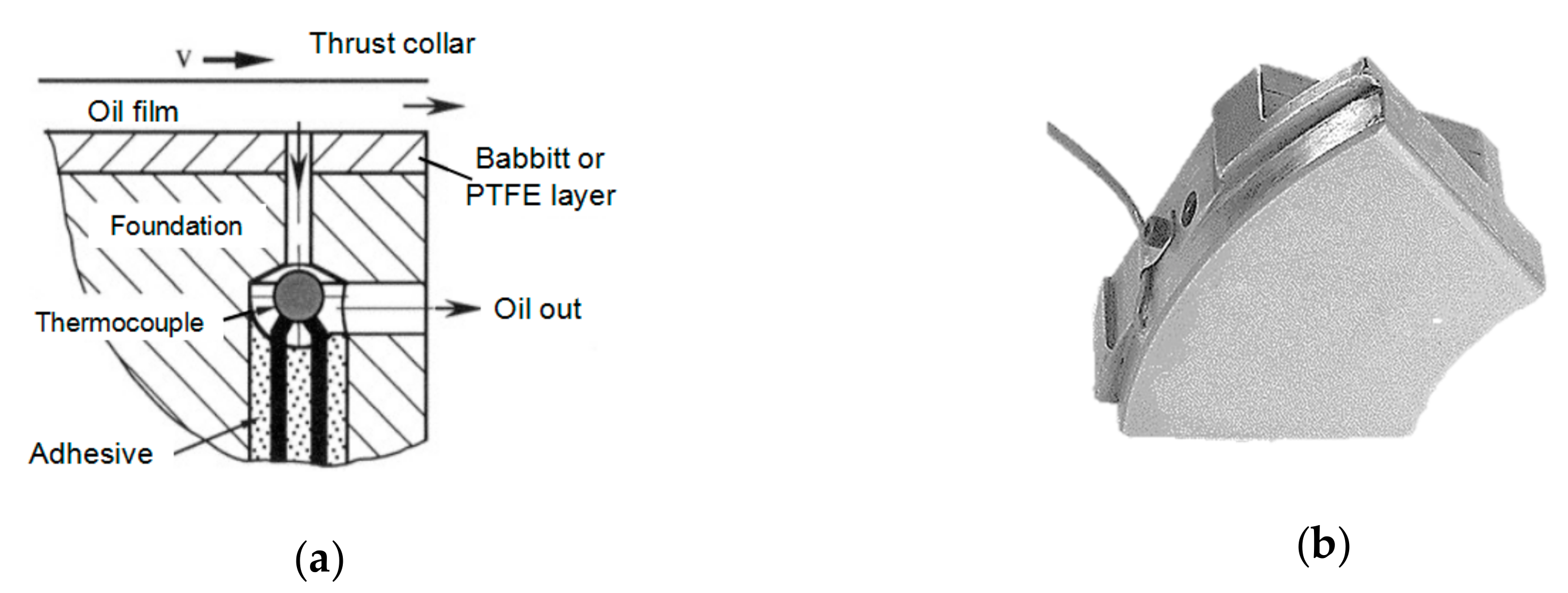
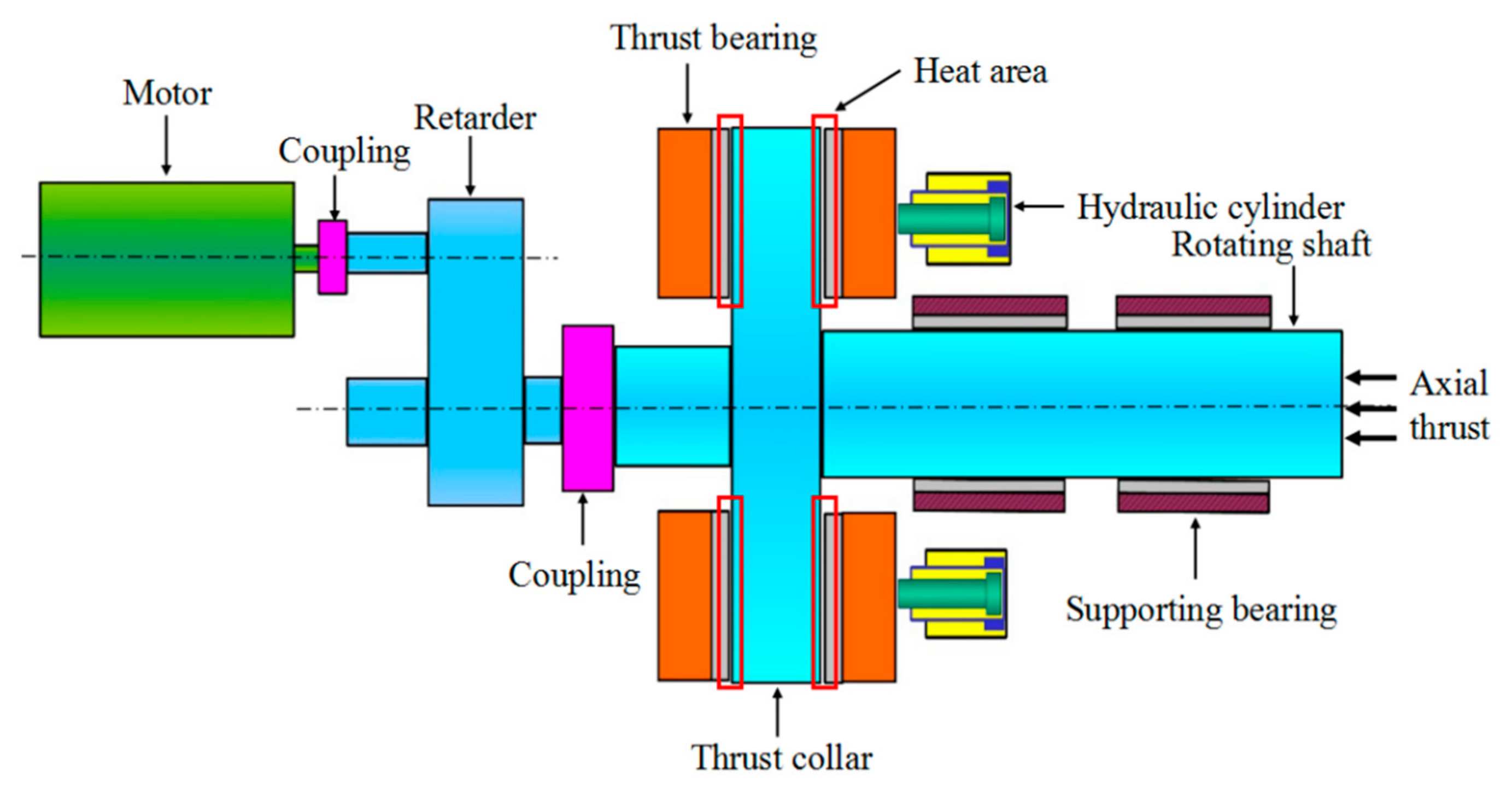
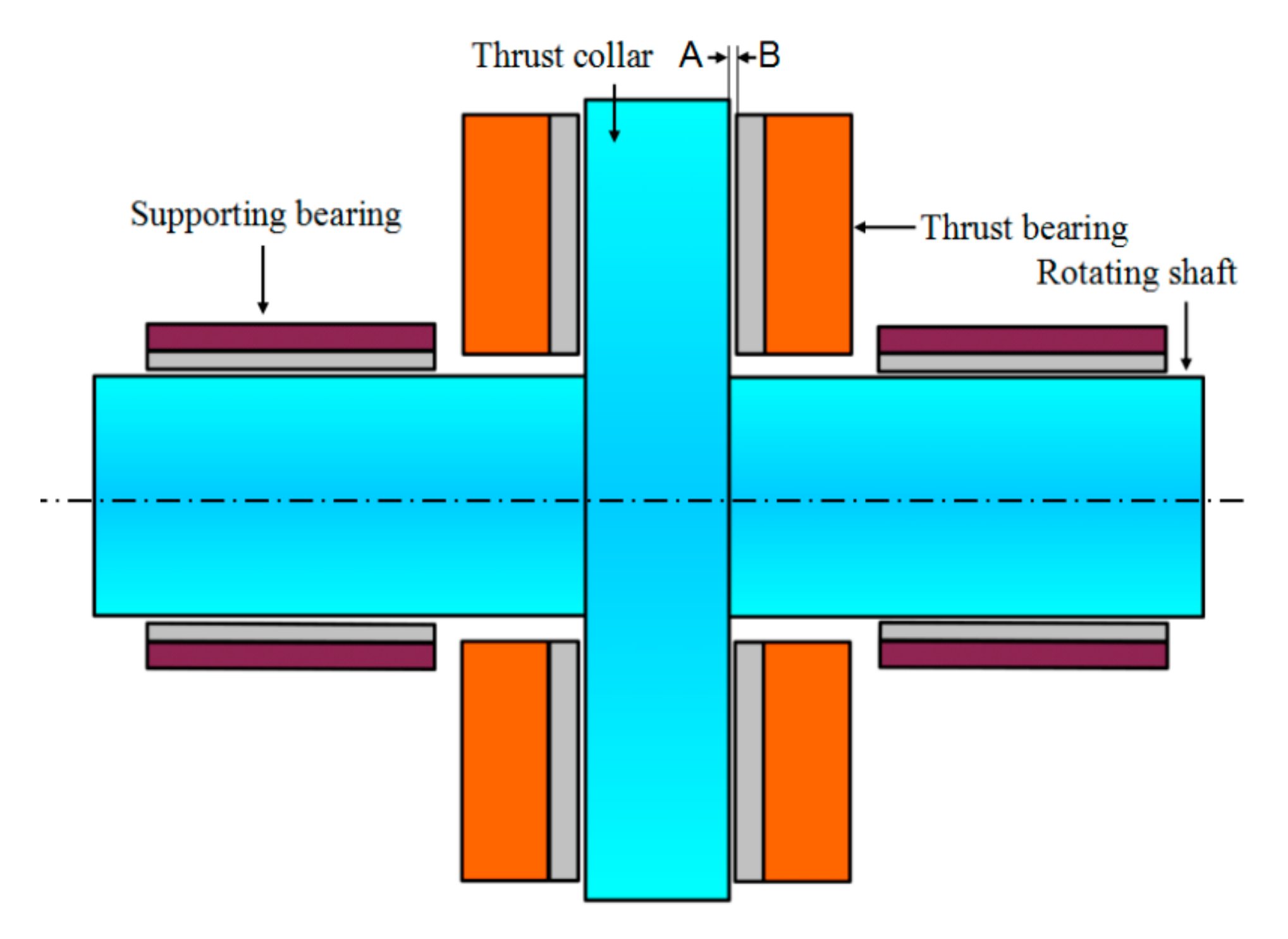


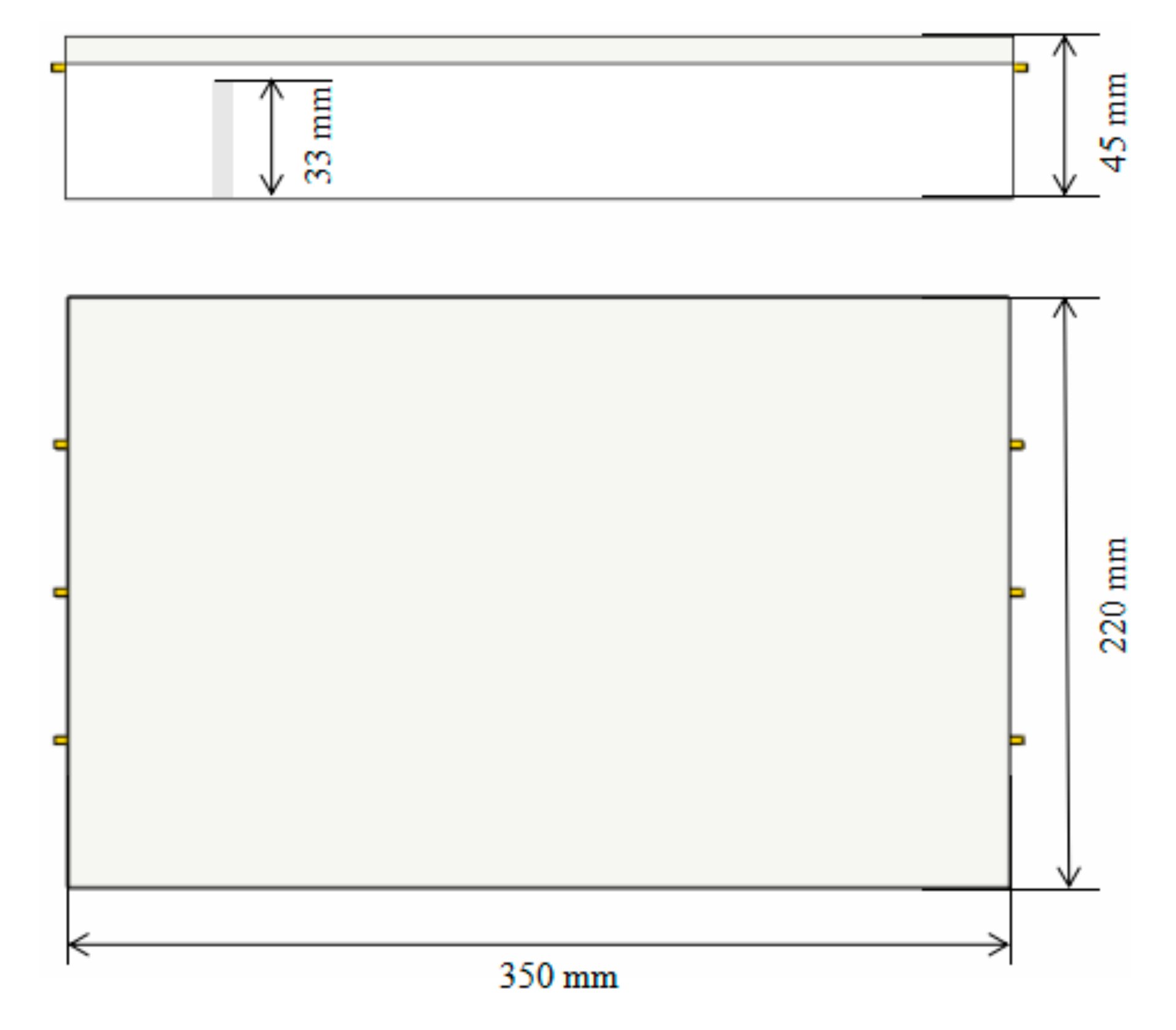
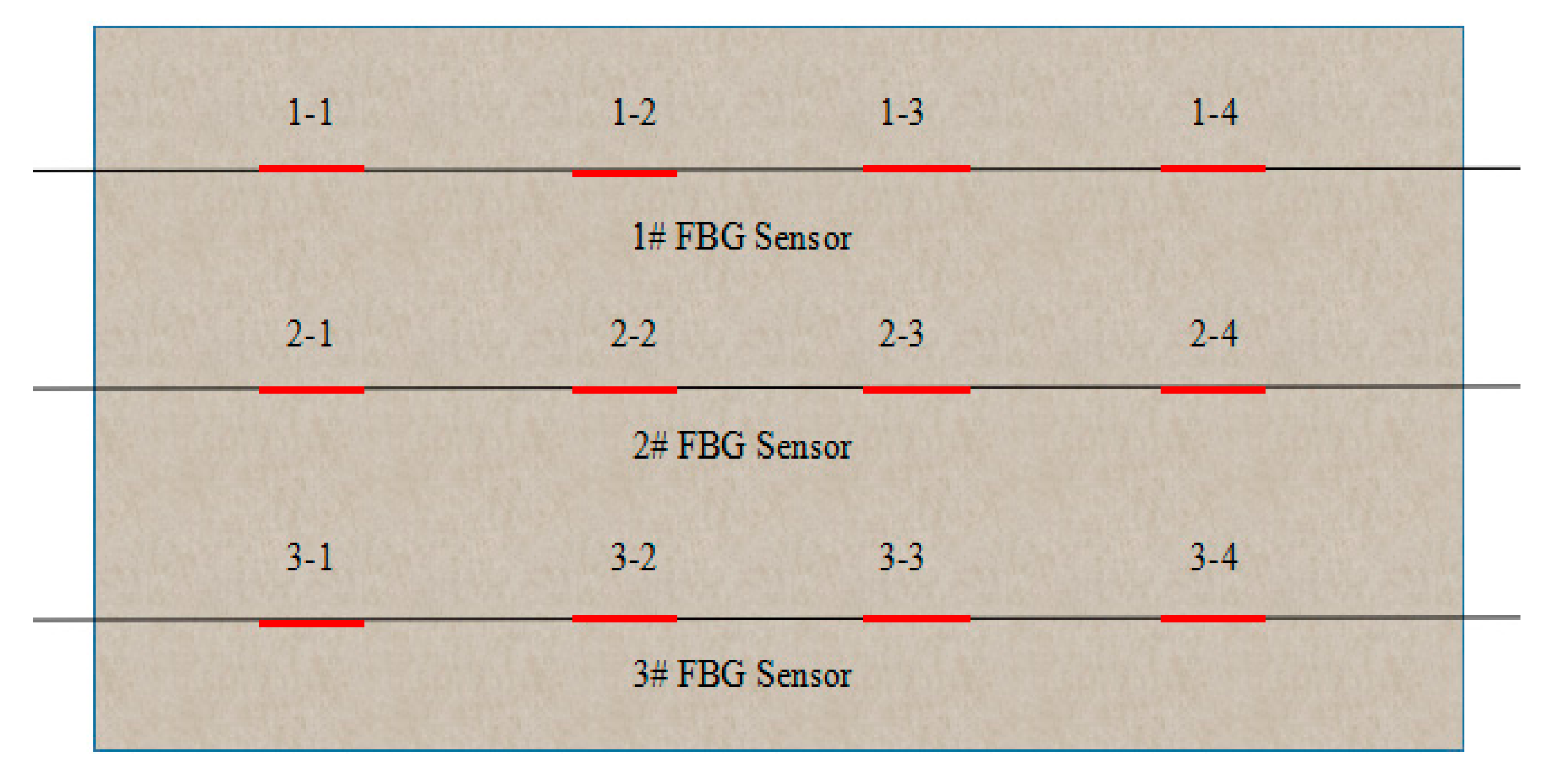
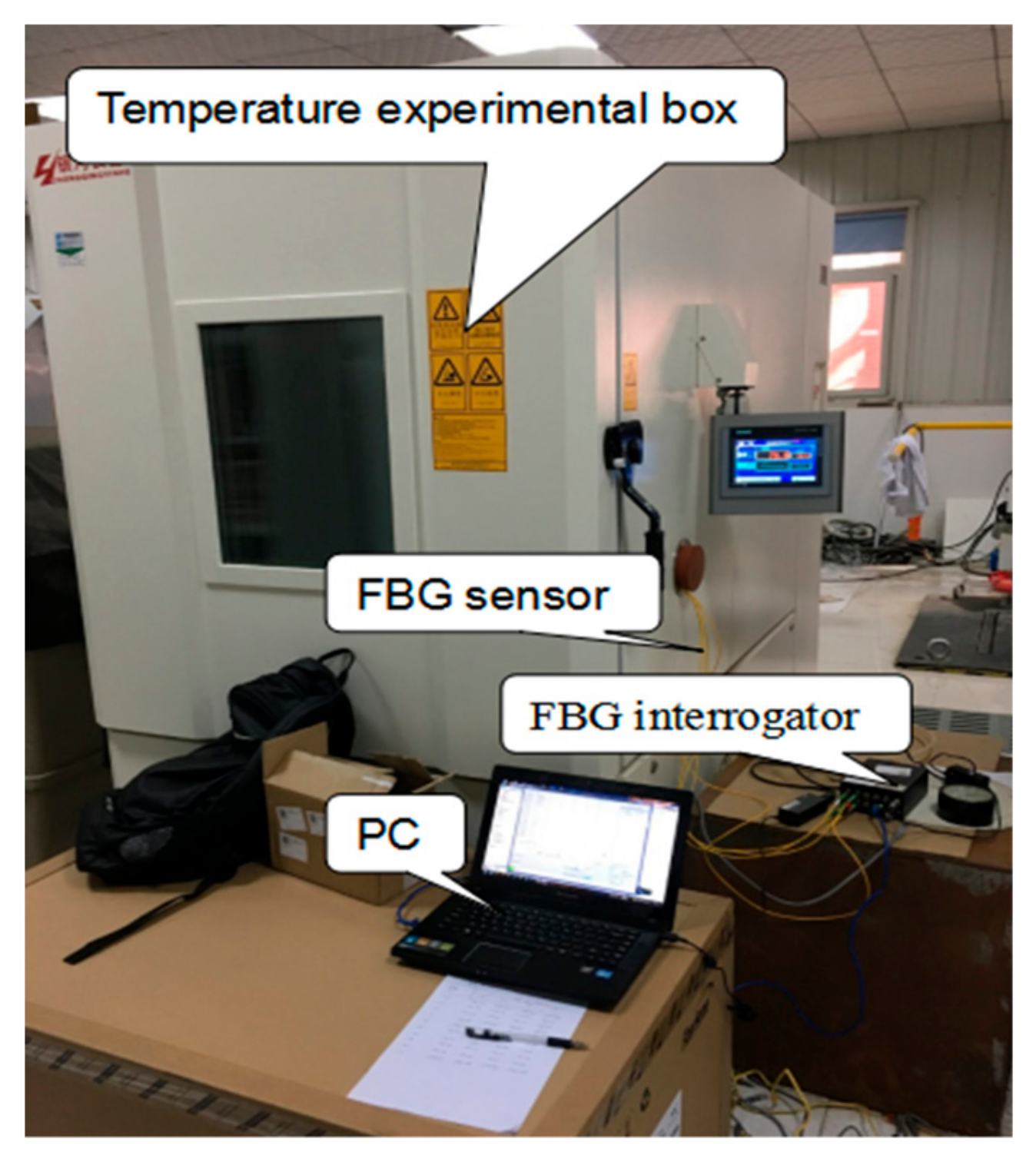





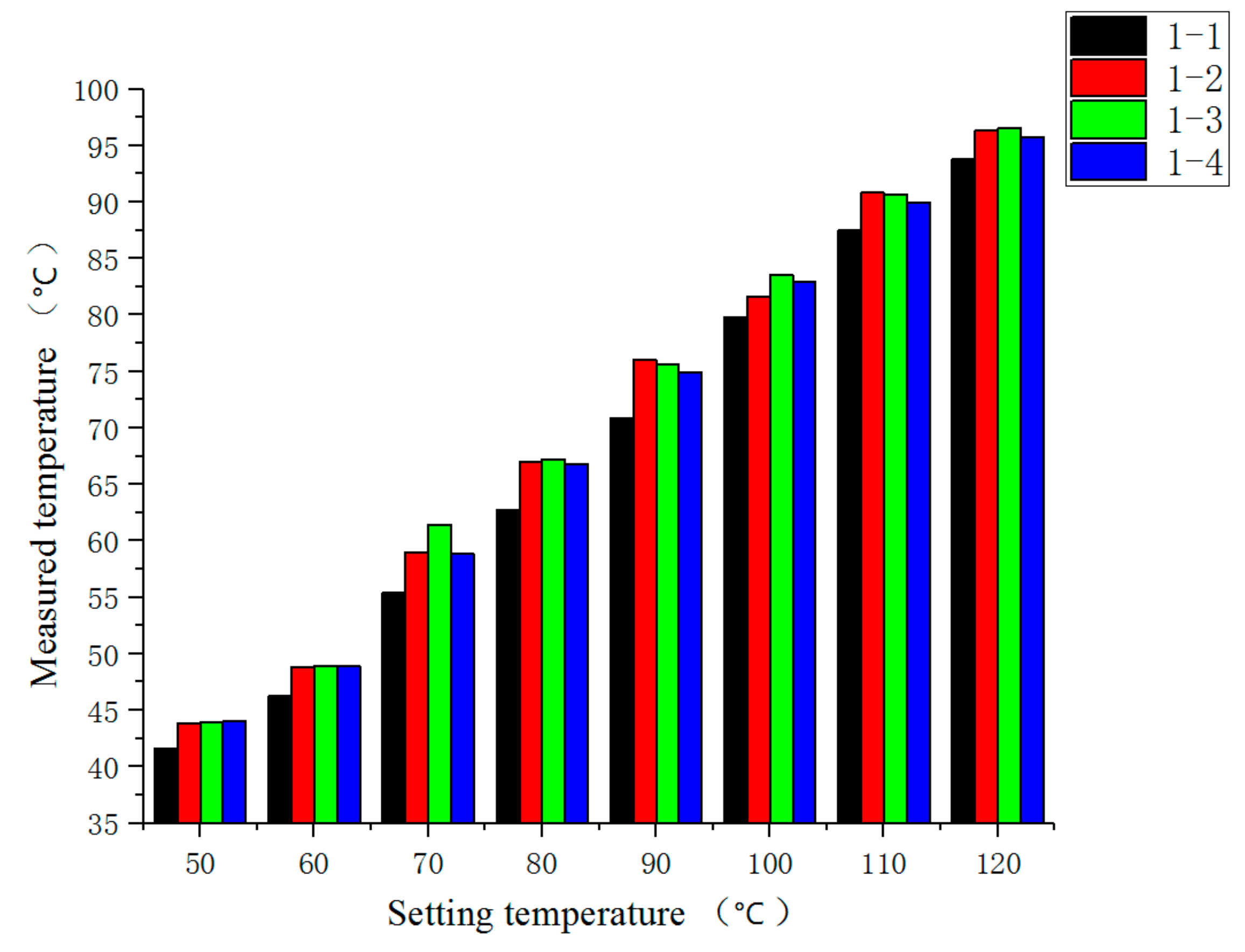
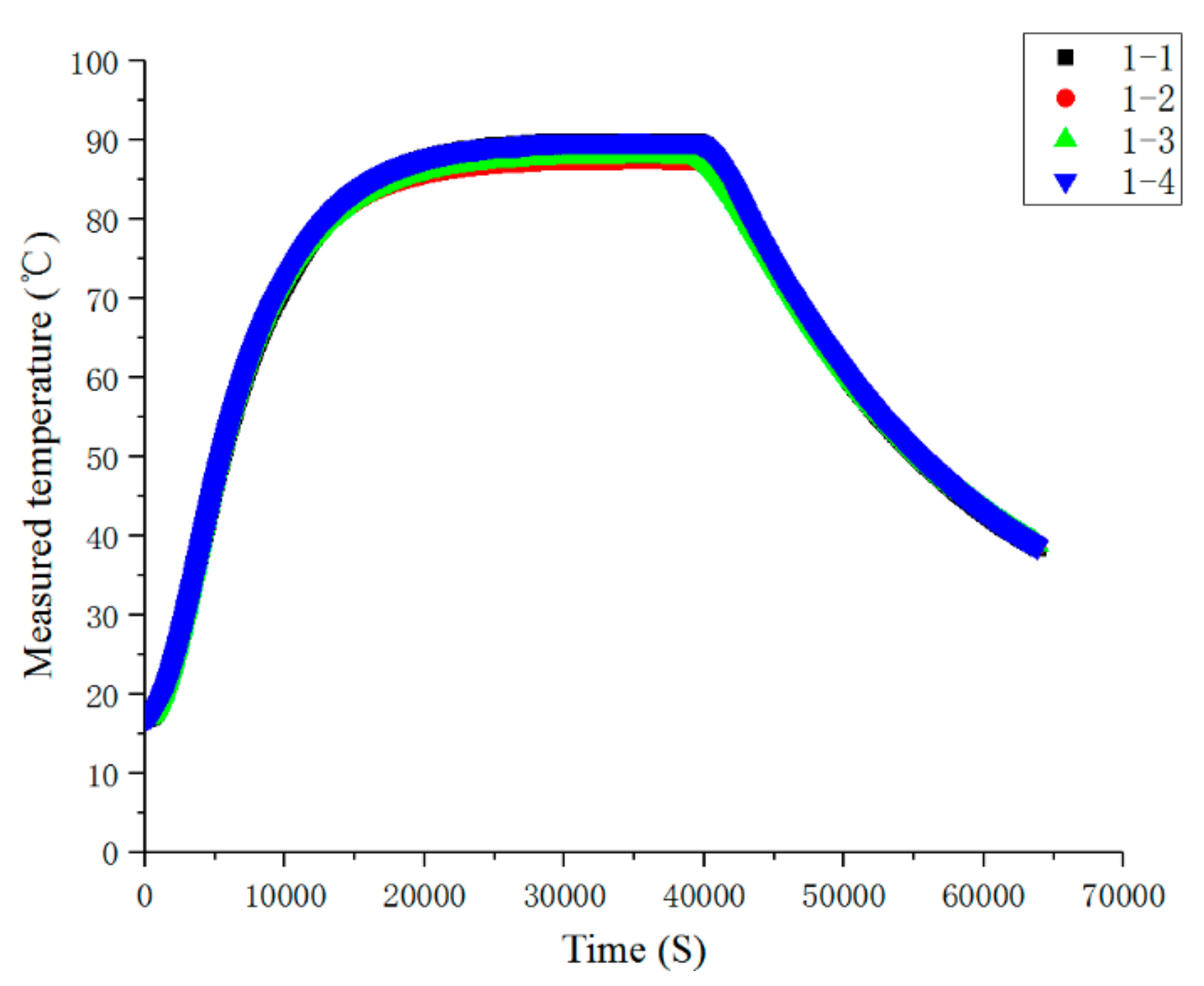

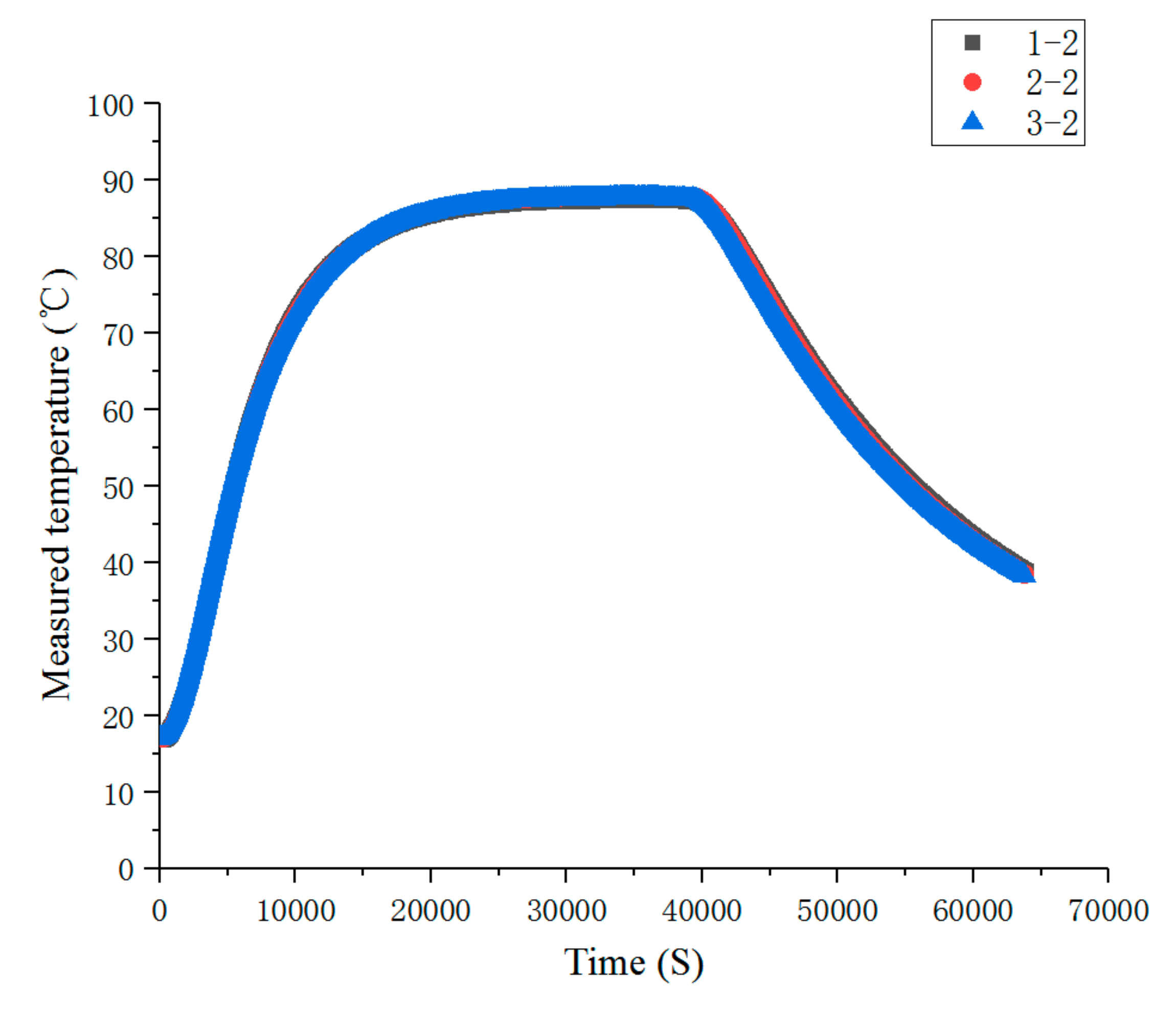
| Number of Measuring Points | The Temperature Sensitivity (pm/°C) | Linearly Correlation Coefficient |
|---|---|---|
| 1-1 | 27.520 | 0.9993 |
| 1-2 | 24.846 | 0.9999 |
| 1-3 | 24.945 | 0.9998 |
| 1-4 | 25.129 | 0.9996 |
| 2-1 | 10.477 | 0.9991 |
| 2-2 | 10.557 | 0.9992 |
| 2-3 | 10.589 | 0.9989 |
| 2-4 | 10.614 | 0.9991 |
| 3-1 | 10.556 | 0.9992 |
| 3-2 | 10.431 | 0.9991 |
| 3-3 | 10.552 | 0.9991 |
| 3-4 | 10.369 | 0.9990 |
| Number of Sensors | Point 1 | Point 2 | Point 3 | Point 4 |
|---|---|---|---|---|
| 1# sensor | 1535.873 | 1540.021 | 1543.967 | 1547.859 |
| 2# sensor | 1535.955 | 1539.970 | 1543.945 | 1547.940 |
| 3# sensor | 1535.991 | 1539.962 | 1543.959 | 1547.913 |
© 2019 by the authors. Licensee MDPI, Basel, Switzerland. This article is an open access article distributed under the terms and conditions of the Creative Commons Attribution (CC BY) license (http://creativecommons.org/licenses/by/4.0/).
Share and Cite
Liu, H.; Yu, Q.; Tan, Y.; Xu, W.; Huang, B.; Xie, Z.; Mao, J. Feasibility Study on Temperature Distribution Measurement Method of Thrust Sliding Bearing Bush Based on FBG Quasi-Distributed Sensing. Sensors 2019, 19, 3245. https://doi.org/10.3390/s19143245
Liu H, Yu Q, Tan Y, Xu W, Huang B, Xie Z, Mao J. Feasibility Study on Temperature Distribution Measurement Method of Thrust Sliding Bearing Bush Based on FBG Quasi-Distributed Sensing. Sensors. 2019; 19(14):3245. https://doi.org/10.3390/s19143245
Chicago/Turabian StyleLiu, Hu, Qiang Yu, Yuegang Tan, Wenjun Xu, Bing Huang, Zhichao Xie, and Jian Mao. 2019. "Feasibility Study on Temperature Distribution Measurement Method of Thrust Sliding Bearing Bush Based on FBG Quasi-Distributed Sensing" Sensors 19, no. 14: 3245. https://doi.org/10.3390/s19143245
APA StyleLiu, H., Yu, Q., Tan, Y., Xu, W., Huang, B., Xie, Z., & Mao, J. (2019). Feasibility Study on Temperature Distribution Measurement Method of Thrust Sliding Bearing Bush Based on FBG Quasi-Distributed Sensing. Sensors, 19(14), 3245. https://doi.org/10.3390/s19143245





